Adapting climate science in the spring of COVID
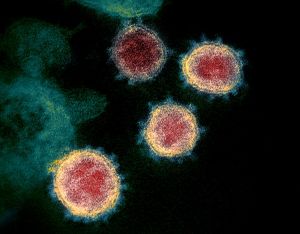
While many are working to figure out how to live in this strange shutdown world during the COVID pandemic, PI-CASC-funded climate scientists struggle to continue their important work. The impact to ongoing research is quite variable because of a wide range of active project parameters and responsibilities: single researcher lab work; multi-person, multi-location collaborations; overseas field work; local field equipment maintenance by helicopter; supercomputing, multi-core modeling processing; and lap-top number-crunching. Each situation is affected differently, but all seem to be impacted in at least some way.
Curt Storlazzi (of the USGS Pacific Coastal and Marine Science Center) has begun a PI-CASC project focusing on US-Affiliated Pacific Island (US-API) locations, researching the effects of sea-level rise on short-term flooding and future long-term inundation of national parks and wildlife refuges throughout the Pacific. Many parks and refuges are on low-lying atolls or coastal plains of high-islands and are thus vulnerable to high wave activity during storms, particularly with an elevated baseline from sea-level rise.
One might think this modelling-heavy work has the advantage of simply needing computer time to achieve progress. Unfortunately, the complexity of the modeling requires high-powered computing on multiple inaccessible platforms.
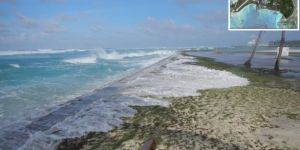
“With the shutdown, we cannot be in the buildings frequently to work on our numerical modeling machines, which are off the network, and university partners are facing the same issues,” says Storlazzi. And the model computations are not like just running a routine in the background on a home laptop. “We have 160 cores slotted for 40 days runtime, or the equivalent of 1 core running for over 17 years.” These are involved calculations!
He estimates that the project will be behind by at least three months. To make matters worse, “our lead modeler has been stuck in Spain for the past month. It’s kind of hard to run models here in California from there.”
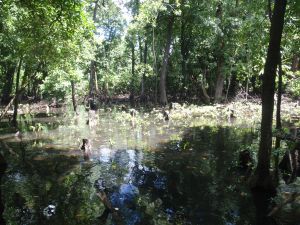
Karen Thorne (of the USGS Western Ecological Research Center) is also overseeing a new sea-level rise project across the Pacific, exploring its ramifications on Kosrae and Pohnpei mangrove forest resilience. The rate of sea-level rise, combined with local development, may be outstripping the forests’ natural ability to grow upwards and inland, threatening this valuable local resource. Thorne’s project aims to evaluate how well mangroves are coping by exploring variables such as sedimentation and accretion rates, ages, biomass changes, salinity, and bulk density, to compare with topography and local sea-level rise rates.
While some preliminary data had been gathered last summer and fall, collaborators were scheduled to fly down to Kosrae in March to collect more elevation and salinity data along new transects of the forests to improve model projections of carbon sequestration. During the same trip, there were plans to hold workshops with local managers, government representatives, and community members to record local perceptions of mangrove services and threats, and to disseminate informational videos of preliminary results to start encouraging conservation efforts.
However, while a collaborator was in transit, the Micronesian government imposed restrictions on gatherings and foreign travel into the country, reducing forward progress mostly to analyzing previously collected data. “With Wifi slow and intermittent on the islands, in-person meetings are the most effective and rewarding way to communicate science and the threats of climate change,” said Thorne, but she says they area also compiling informational handouts and open access reports for distribution to stakeholders in the meantime.
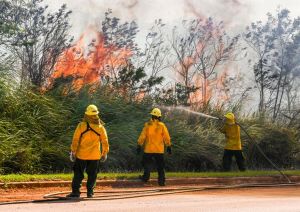
A new project led by Abby Frazier (with the East-West Center at the University of Hawai‘i at Mānoa) also has a large component of gathering stakeholder input from islands as widespread as Maui, Guam, Palau, and Yap where managers are increasingly having to cope with extended drought and wildfire seasons. Frazier’s work will be mimicking a project conducted on Hawai‘i Island where managers worked collaboratively with researchers to develop science-based products to aid decision-making and planning for future drought and fire events. However, the shutdown has stymied this co-production work, too.
“Not being able to travel and meet with our partners in-person has delayed the start of our project objectives,” said Frazier. “We had to cancel our in-person meeting on Maui that was scheduled for March, and have not been able to connect with that partner virtually, yet.” Likewise in Guam, Frazier is considering switching to virtual meetings as well as relying more heavily on local partners. But at the time of the shutdown, the Palau and Yap work had not even reached the stage of making the necessary personal connections, so the travel restrictions will delay beginning efforts there even longer.
Progress on mature projects based in Hawai‘i by local researchers is not a guarentee either, with restrictions in place on inter-island travel sometimes hampering work as much as international restrictions do.
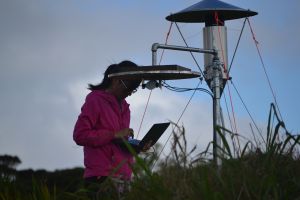
For several years using instrument stations on Maui, Tom Giambelluca’s group (from the Geography Department at UH Mānoa) has been studying the effects of a shifting climate on the process of cloud water interception, the accumulation of potentially significant amounts of precipitation via cloud droplets (fog) being driven onto plant surfaces and then falling to the ground. This spring and summer there were plans to retrieve data from several sites as well as begin preparations for removing equipment at the end of the project.
“We found it necessary to cancel field trips we had planned,” said Giambelluca. “This has caused delays of unknown length, will probably result in data gaps, and will impose costs that we will be unable to meet within our project budget.” Most of these costs are for personnel and helicopter support for attending to and removing field equipment in locations that are logistically difficult to reach by other means. And finances will become more complex as the end of the fiscal year approaches in the fall.
Giambelluca also sees financial worries in the likelihood of funding cuts from the state to the university. “We will be looking more than ever to find federal support for research,” he said. Many project leaders may find themselves in a situation of needing to navigate the bureaucracy of no-cost extensions.
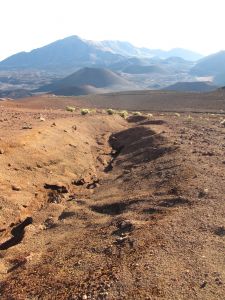
One recent PI-CASC project that seems to have not been derailed is led by Lucas Fortini (of the USGS Pacific Island Ecosystems Research Center). He is examining the effects of vegetative changes that alter soil infiltration dynamics, causing excess runoff that increases erosion rates of terrestrial habitats and sediment loads into coastal ecosystems. Specifically, he is modelling risk conditions at Haleakalā National Park on Maui to help managers prioritize planning for runoff and erosion within the park.
Because the project is essentially completely computer-based at this stage, Fortini says the work has not been affected by the shutdown. “I guess (it’s) one of the small benefits of being a quantitative ecologist: always number crunching!” Fortini joked. However, he did note that he has had to take time off to oversee his child’s schooling at home with the closure of local schools for the semester.
PI-CASC as a whole has seen elements of disruption and uncertainty, but also signs of persistence. Our long planned Research Symposium before the annual University of Guam Center for Island Sustainability Conference at the end of March had to be cancelled, although the CIS Conference itself pivoted to become a series of online events taking place every Thursday (ChST) in May and the first week of June. It is up in the air whether the first expanded PI-CASC Summer Undergraduate Research Fellowship (SURF) program will be able to begin next month for an amazing cohort of students.

But there are some silver linings. Activities that can move online are making that transition. For example, we were able to hold a successful webinar and virtual panel discussion on the efforts to address invasive species in a changing climate the first week of May. And a science symposium planned for this fall is being re-imagined as a virtual event.
In addition, people of all walks are showing great patience for one another’s situations. Fortini reported that “despite the move to virtual meetings, I have fewer (meetings) scheduled as people have been more mindful of each other’s time during this period of crisis.” And Frazier has found that “my colleagues have been extremely compassionate during this time and understand that everyone is doing the best that they can.” She added, “I am grateful for the flexibility and understanding that most people seem to have right now.”
We hope the next few months will see a return to something resembling normality so that we can all get back to addressing fully the critical climate adaptation work that needs to continue.

